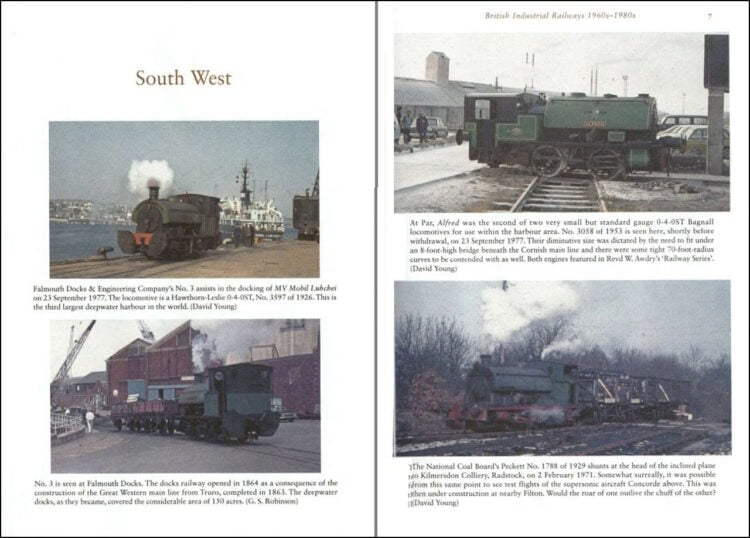This book illustrates scenes of trains and locomotives in industrial settings throughout the UK, from Cornwall in southwest England to central Scotland.
Published in March 2023 by Amberley Publishing and written by Peter J. Green, this soft cover book measures around 23.4 cm x 16.5 cm, and has 96 pages and 180 illustrations. It has a published price of £15.99 although Amberley Publishing currently has it on offer at £14.39, and at the time of writing, it can be obtained from Amazon for £11.89.
The term Industrial Railways conjures up images of dirty locomotives at work in equally dirty conditions. This book lives up to that image, although there are plenty of examples of locomotives with a respectable degree of cleanliness.
The book has a two-page Introduction that concentrates more on the evolution of railways than as a prelude to the book and gives a brief history of the National Coal Board and Central Electricity Generating board rather than introducing what the book is about. There follows chapters covering different areas of the UK starting with the South West, followed by the South East, London, Midlands, Wales, North West, North East, Cumbria, and Scotland. Quite why Cumbria warrants its own chapter is a mystery as there are many other counties that had more extensive networks of industrial railways, particularly Northamptonshire with its many miles of railways around the county's ironstone quarries.
Strangely, the chapters are preceded by a page titled “The Beginnings” showing a plaque in Deptford southeast London to Richard Trevithick and a photo of a replica of Stephenson's Rocket. Similarly, the last page is titled “And Finally” but simply shows two locomotives in South Wales.
The major users of railways in industrial settings were mines, quarries, and steelworks, although as this book shows there were plenty of other users. However, in a book of this size there are bound to be omissions, such as the slate quarries in Wales, notably the Talyllyn which according to the book's cover is represented but has been omitted in the published book.
With a wide variety of traction, mostly 0-4-0 or 0-6-0 steam locomotives, but also diesel, electric, and even fireless locomotives this book illustrates a fascinating selection of just a few of the many industrial railways to be found in Britain in the period covered by the book, but there are many examples that are notable by their absence.
Because of their operating conditions, industrial railways often required standard locomotives to be specially adapted. One such locomotive is that shown at the top right below, which was modified to allow it to operate under an 8-foot-high bridge beneath the Great Western main line in Cornwall.

After withdrawal by British Railways, many diesel shunters were sold for industrial use such as the two on the left and the one on the bottom-right below.
The photos on the left and the top-right below are scenes from the former Post Office railway that used to run under the streets of London. Like many photos in the book, these are let down by poor reproduction.
Northeast England had a large network of many miles of industrial railways, and the photos on the left-hand page below represent typical examples. Unusually, some of the installations in northeast England were electrified, and one such example is shown at the bottom right. The train at the top right does not really quality for inclusion in this book as it is an engineering train on the public network of the Tyne and Wear Metro.
The National Coal Board had an extensive network of lines around Ayrshire in Scotland, and the four photos below show typical examples of trains at work on this system.
This book includes a wide selection of photographs of industrial sites with locomotives ranging from filthy to a respectable degree of cleanliness. It is organised in chapters covering different areas of the UK, but quite why they are preceded by a page titled “The Beginnings” and one titled “And Finally” is a mystery.
With the large numbers of industrial railways that were operational during 1960s to 1980s, it is largely subjective which ones should be included in a book of this size, but when the book's cover refers to a particular railway, as in the case of the Talyllyn, there is no excuse for it to be omitted from the published book.
Some railways have more than their fair share of entries, such as the Longmoor Military Railway with nine pages of photos, which is excessive and compounded by not being an industrial railway in its truest sense.
Although the book is divided into chapters, the page headings all repeat the book's title rather than including the chapter title. Also, the absence of a Contents list leaves the reader in the dark as to what to expect from the book; neither is there a detailed index.
This is an interesting reprise of some of Britain's industrial railways towards the end of the 20th century, but is let down by some cases of poor photographic reproduction, an unbalanced selection of photos, and an attempt to cover the whole of the UK in a single small volume.
The book is available to purchase from Amazon and from Amberley Publishing.
We would like to thank Amberley Publishing for providing us with a copy of the book for review.